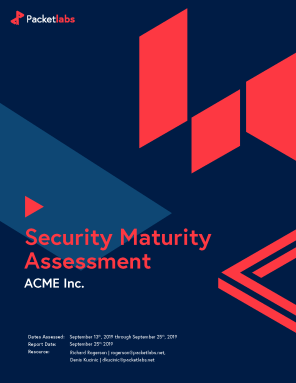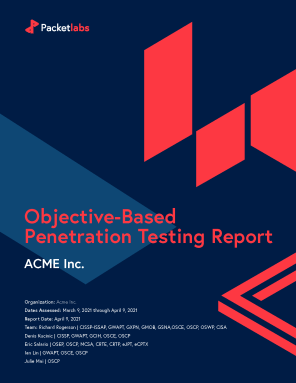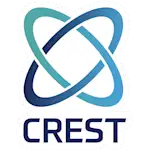Compliance A Primer On Long-Term Digital Archive Storage
Would you like to learn more?
Download our Pentest Sourcing Guide to learn everything you need to know to successfully plan, scope, and execute your penetration testing projects.
Does your organization utilize long-term digital archive storage?
Long-term digital archives are essential for organizations for various legal, operational, and strategic reasons. Maintaining long-term digital archives is not just about meeting compliance requirements but also about mitigating risks, ensuring business continuity, and providing services to customers.
Let's dive into their various areas of importance:
Cybersecurity Benefits of Retaining Long-Term Digital Archive Storage
Here are some top reasons that organization's need to keep long-term digital archives:
Legal and Compliance Responsibilities: Many industries are subject to strict regulatory frameworks that require the retention of specific records for extended periods such as Sarbanes-Oxley Act (SOX) for financial records and HIPAA for patient records. Failure to maintain proper records can result in hefty fines, penalties, and legal action
Risk and Governance: If an organization's systems are compromised, either by a cyberattack or operational failures, having access to historical data ensures that crucial information can still be retrieved. Also, good governance practices require organizations to track decisions, activities, and transactions to ensure accountability and transparency
Customer Services and Accountability: For organizations that offer services to customers, maintaining a long-term digital archive is often part of their customer service obligations. Contracts, purchase records, or communications may need to be retrieved to address customer inquiries, support warranty claims, or resolve disputes.
Business Continuity and Disaster Recovery: Long-term digital archives support an organization's business continuity planning. In the event of a system failure, natural disaster, or cyber incident, an archive provides a backup repository of critical data that can be used to resume operations.
Knowledge Preservation and Institutional Memory: Over time, organizations accumulate valuable information that may be critical for future decision-making, research, or historical purposes. Digital archives allow organizations to preserve institutional knowledge, such as past projects, strategic decisions, and proprietary research.
Intellectual Property and Strategic Value: For organizations that generate intellectual property (IP), such as patents, designs, or copyrighted works, digital archives protect these assets over the long term. Historical data can provide evidence in legal disputes involving IP rights or provide strategic value by offering insights into long-term market trends, customer behaviors, and business performance.
Things to Consider When Planning Long-Term Digital Archives
When establishing and managing long-term digital archives, organizations must carefully consider several key factors to ensure the confidentiality, integrity, and availability (CIA Triad) of their archived data. Organizations must balance the priorities of privacy, ensuring data integrity, and legal compliance while balancing costs, the limitations of each media type, and maintenance concerns. Effective planning can help ensure that long-term archives remain a valuable asset rather than a liability.
Privacy and Data Classification: One of the foremost concerns for long-term digital archives is ensuring that sensitive data is properly classified and protected. Not all data is created equal, and some may contain personally identifiable information (PII) subject to privacy regulations, such as GDPR and CCPA, intellectual property, or confidential business details. Classifying data appropriately helps organizations apply the correct security measures to protect it.
Integrity of the Data Being Archived: Over time, data stored on digital media can degrade, leading to corruption or loss of information. Verification techniques such as regularly validating checksums, and error correction must be employed to ensure that the data remains intact. The ability to prove that data has not been tampered with is especially important for legal purposes, audits, and regulatory compliance.
Legal Considerations: Legal requirements for data archiving can vary significantly depending on industry and location. Organizations must understand the regulatory landscape governing data retention, including how long specific types of information must be retained and under what conditions it can be deleted.
Cost of the Solution: Organizations must weigh the benefits of long-term storage against its costs. Expenses may include hardware and software investments, cloud storage fees, and ongoing operational costs such as power, environment controls for optimal temperature and humidity, and maintenance costs for periodically verifying the backup integrity and migrating archived data before the media expires. Organizations must also consider scalability, as the amount of data requiring storage will likely increase over time, adding to the overall cost.
Required Maintenance of the Media Format: Digital storage media, whether physical (like hard drives, tapes, or optical discs) or cloud-based, require regular maintenance and updates to ensure long-term viability. The lifespan of all storage media is limited, necessitating migration to fresh media. Failure to do so could result in unreadable archives, causing data loss or making retrieval more costly and time-consuming.
Data Security and Access Control: Archives are valuable and could become targets for cyberattacks or attempts at physical access. Ensuring that archived data is secure and accessible only by authorized personnel requires encryption, multi-factor authentication (MFA), and role-based access controls. Organizations must have clear policies outlining who can access data and under what circumstances, especially for sensitive or classified information.
Disaster Recovery and Redundancy: Long-term digital archives should be part of an organization’s overall disaster recovery plan. This includes having redundant copies of the data stored in geographically separate locations, whether on different physical media or in multiple cloud environments.
Recognized Standards For Long-Term Storage
Recognized authorities on industry best practices for data storage and archiving, which are widely recognized by organizations specializing in data management, digital preservation, and information technology.
Here are some credible sources of information for planning long-term storage:
The U.S. National Archives and Records Administration (NARA): The NARA Digital Preservation Framework provides guidelines for long-term digital preservation, covering storage media, lifespan, and data integrity checks.
International Standards Organization (ISO): ISO provides frameworks for digital preservation, data integrity, and archival storage management. ISO 14721: Open Archival Information System (OAIS) and ISO 16363 are referenced for long-term digital preservation.
Cloud Providers: Major cloud storage providers like Amazon AWS, Microsoft Azure, and Google Cloud offer documentation on best practices for cloud storage, cold storage, and archival solutions.
The Linear Tape-Open (LTO) Consortium: The LTO offers extensive information on the use of magnetic tapes for long-term storage, including recommended best practices for storage, environmental controls, and migration schedules.
Society of American Archivists (SAA): Digital Preservation Resources from SAA offer guidelines for long-term digital storage, covering different media formats, data integrity checks, and migration strategies.
Media Options For Long-Term Data Storage
When considering long-term data storage, organizations have several options, each with its own advantages, limitations, and maintenance needs. Below is an overview of the main storage methods and the specific requirements for maintaining data integrity over time.
Magnetic Tape Storage: A popular option for long-term data archiving due to their high capacity and low cost per terabyte. They are often used for enterprise backup systems and cold storage, where data is rarely accessed. Tapes typically have a lifespan of 10-30 years, depending on environmental conditions and should be verified annually to check for degradation or corruption, migrated every 10-15 years, and stored in controlled environments (temperature: 15–25°C, humidity: 20–50%) to prevent degradation.
Mechanical Hard Disk Drives (HDD): A common storage medium for both active and long-term storage due to their affordability and speed. However, mechanical drives are prone to mechanical failure and suffer from bit rot (data corruption) over time. HDDs have an expected lifespan of 3-5 years and should be tested for failure or bad sectors every 1-2 years. Data should be migrated every 5 years to ensure integrity.
Solid-State Drives (SSD): Gaining popularity for long-term storage due to their speed and durability, though data retention in SSDs can degrade, especially in high-temperature environments. SSDs can last 5-10 years, though retention may be shorter (1-3 years) if powered off for extended periods. SSDs should be tested every 2-3 years and data should be transferred after 5-7 years, and they should be stored at temperatures below 40°C to maximize retention.
Optical Discs (Blu-ray, DVD, CD): Offer a cost-effective method for storing smaller amounts of data. Archival-quality discs can last 50-100 years, while standard DVDs or CDs have a lifespan of 5-10 years. If standard discs are used, data should be checked every 2-5 years and transferred to new media every 5-10 years. Archival-grade discs may not require transfer for up to 50 years. Discs should be stored in cool, dry, dark environments to prevent physical degradation.
Cloud Storage: Popular for long-term data archiving due to its scalability, accessibility, and minimal management needs. Cloud storage does not have a fixed lifespan, as providers manage data replication, migrations, and hardware failure on the backend.
Laser-Etched Glass Storage (Project Silica): GitHub, in collaboration with Microsoft’s Project Silica, has developed a cutting edge technology for long-term data storage that uses laser etching into glass at a nanoscale level. This technology is estimated to last for thousands of years and is resistant to environmental factors such as high temperatures, electromagnetic pulses, water, and scratches. The project is still in the experimental phase, but glass storage can encode a significant amount of data (terabytes) onto a small piece of glass. GitHub, through its GitHub Arctic Code Vault, used this technology to preserve open-source code for future generations by etching it into glass, which was then stored in an Arctic vault.
Conclusion
In summary, ensuring reliable long-term digital archive storage requires organizations to balance data security, legal compliance, and cost considerations. Key strategies include implementing robust data classification, maintaining media integrity through regular checks and migrations, and leveraging appropriate storage solutions—whether physical or cloud-based. Organizations must also follow best practices from industry authorities, such as ISO or NARA, and if your budget allows, you may consider evolving technologies like laser-etched glass for extreme durability.
Let's Connect
Share your details, and a member of our team will be in touch soon.
Reports

Cyber Maturity Assessment Report
Packetlabs assessed the security control capabilities of ACME Inc.’s security program using the ISO/IEC 27001:2022 framework.
Download Sample Report
OBPT Sample Report
Packetlabs’ OBPT methodology evaluates the security controls across people, processes and technology in order to identify potential areas of weakness.
Download Sample ReportExplore in-depth resources from our ethical hackers to assist you and your team’s cyber-related decisions.

September 13 - Blog
Why Multi-Factor Authentication is Not Enough
Knowing is half the battle, and the use and abuse of common frameworks shed insight into what defenders need to do to build defense in depth.

November 19 - Blog
The Top Cybersecurity Statistics for 2024
The top cybersecurity statistics for 2024 can help inform your organization's security strategies for 2025 and beyond. Learn more today.

October 24 - Blog
Packetlabs at SecTor 2024
Packetlabs is thrilled to have been a part of SecTor 2024. Learn more about our top takeaway's from this year's Black Hat event.







